![]()
![]()
![]()
Use LEFT and RIGHT arrow keys to navigate between flashcards;
Use UP and DOWN arrow keys to flip the card;
H to show hint;
A reads text to speech;
45 Cards in this Set
- Front
- Back
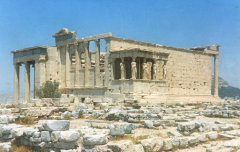
The Erechtheion, Acropolis, Athens
Greek Classical |
The Erechtheion, Acropolis, Athens, 421-405 BCE
-Rebuild of the Archaic Athena temple that the Persians had destroyed. -multiple shrines: Athena, wooden image of Panthenaic festival goddesses, & several other gods & demigods |
|

Erechtheion Plan
Greek Classical |
Erechtheion Plan
-asymmetrical plan unique, anti-thesis of Doric plan of harmony - need to incorporate pre-existing features of existing shrines, trident mark, & olive tree into a single complex |
|

Carytids
Greek Classical |
Carytids, from the Ionic Erechtheion
-replaced ionic columns - supported flat roof - combined structural, weight-bearing legs with a feminine, natural, flexible form. |
|
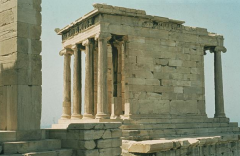
Temple of Athena Nike
Greek Classical |
The Temple of Athena Nike, Acropolis, Athens
- designed by Kallikrates - 4 columns on east & west facades - includes reference to victory over Persians in name & frieze -decisive battle of Marathon -- losers shown as humans |
|
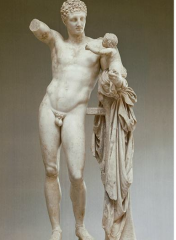
Hermes & Dionysus
Greek 4th century |
Hermes & Dionysus, Praxtiles
- displays common human tender interaction - body forms "s" curve, exaggerated contrapposto - Gods possess a beauty mortals can actually aspire to, no longer put on a pedestal of absolute perfection -humanistic |
|
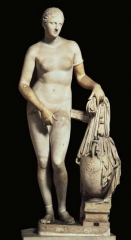
Aphrodite of Knidos, Praxtiles
Greek 4th Century |
Aphrodite of Knidos, Praxtiles
-1st female nude of Greek art - rejected by commissioner & redone w/ clothes - reflects the sexism still in Greek society at the time: woman is hiding her body shyly, caught after a bath in a temporary and private state of nudity. |
|
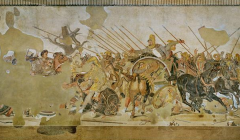
Mosaic of the Battle of Issus, 310 BCE
Greek Hellenistic |
Battle of Issus mosaic, 310 BCE
-depicts Alexander's conquest of the Persian Empire -original: encaustic paint on wood - mosaic shows the advancements of highlighting & shadowing, naturalism of Greek painting, spatial recognition -depicted naturally, not as an allegory |
|
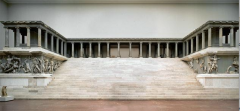
Great Altar of Zeus, Pergamon
Greek Hellenistic |
Great Altar of Zeus, Pergamon
-Ionic order, continuous wrap-around frieze of sculpture of Pergamons & Gauls -very deep relief |
|

Frieze of the Great Altar of Zeus, Pergamon
Greek Hellenistic |
Frieze of the Great Altar of Zeus, Pergamon
-depicts the allegory of the Pergamons as gods and the Gauls as beastly, inhuman giants. -giants could not be killed if they kept contact w/ Earth's surface; image shows Athena grabbing them by the hair to lift them off the surface -images of death, pain, & dying-- Hellenistic |
|

Gaul monument, Pergamon
Greek Hellenistic |
Gaul Monument, Pergamon:
- Gauls are depicted here as perfect & idealized humans- a right previously reserved for the winners only - shows the respect for Hellenized neighbors, under the Greek empire -identified as Gauls by long, bushy hair & mustaches, and the torques (necklaces) worn. -losers are committing suicide |
|
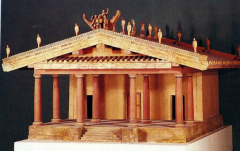
Typical Etruscan temple
Etruscan- Archaic |
Typical Etruscan Temple:
- large front porch (only-- no back porch) - back of building attached directly to precinct wall, forces a frontal view only - columns are at front only, steps located in the center of the porch only - set on a podium- elevates temple - 3 separate cellas for 3 separate gods -"Tuscan Doric Order"--- abacus & echinus, but smooth columns instead of fluted. No base & narrower-- wood instead of stone, lighter material. - roof extends past temple platform to rid roof of rain -sculpture located on roof's ridge |
|
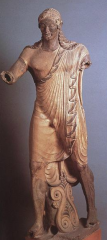
Apollo of Veii
Etruscan- Archaic |
The Apollo of Veii:
-archaic smile, rigid hair -clothed in Etruscan art (not nude as in Greek) -terra cotta clay - legs spaced widely apart, as if walking |
|

Sarcophagus at Ceveteri
Etruscan- Archaic |
Sarcophagus at Cerveteri:
- archaic smile, almond eyes, rigid hair - etruscan aspect: men and women together - terra cotta clay pot, immortalized couple |
|
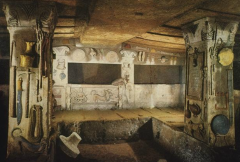
Tomb of the Reliefs, Cerveteri
Etruscan Hellenistic |
Tomb of the Reliefs, Cerveteri:
- mimics typical Etruscan mud-brick home, with "couches" and other seating arrangements, on which cremated remains in pots would sit. - originally pots were plain but gradually transformed over the years to reflect the bodies held inside. |
|
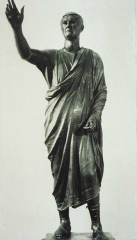
Aule Metele
Etruscan Hellenistic |
Aule Metele:
- "The Orator" -- hand held up indicates he is speaking - expert bronze statue - Roman magistrate- signifies Rome's artistic influence at the time & the transition that was taking place |
|
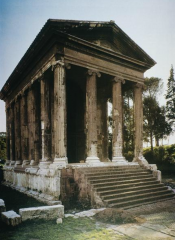
Temple of Portunus, Rome
Roman Republican 509-27 BCE |
Temple of Portunus, Rome:
- dedicated to the Roman god of harbors - high podium, steps only at front-- Etruscan plan + made of stone-- Greek influence = Roman - stucco imitates Greek marble, ionic columns, pseudoperipteral |
|
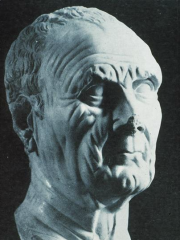
Portrait of an old man
Roman Republic |
Portrait of an Old Man:
- aristocratic patrician, portrayed in the veristic (super realistic) style -brutally distinct features - serious, determined, loyal |
|
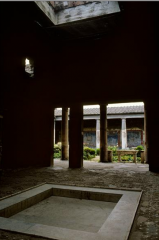
Atrium of the house of the Vetti, Pompeii:
Roman Republic |
Atrium of the House of the Vetti, Pompeii:
- Roman domestic architecture, typical townhouse - impluvium: collects rainwater - peristyle garden behind |
|
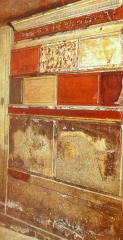
1st style painting from Samnite House, Herculaneum
Roman Republican |
First-Style Painting from the House of the Samnite, Herculaneum:
- aim to decorate by imitating costly marble panels using stucco relief -Greek origin, passed to Herculaneum by the Hellenization of the Greek states |
|
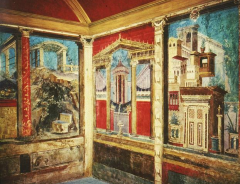
2nd style painting from Bosoreale:
Roman Republican |
2nd style painting from Boscoreale:
- painted on flat surface, rather than sculpted plaster - true-to-life architectural elements -columns support tablature -view beyond columns- seascapes, landscapes, cityscapes, etc. - no real windows b/c of surrounding structures - highlighting, shadowing, spatial & angular methods to provide true perspectives |
|
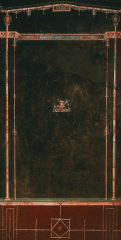
3rd style painting at Boscotrease:
Roman Imperial 27 BCE- 312 AD |
3rd style painting @ Boscotrease:
- incorporates 1st & 2nd style characteristics -exaggerated architecture, columns stretched too thin, not in proper orders - spaces between columns are blank negative space, sometimes with a small image in the center: chunk of landscape or a bird, etc. |
|
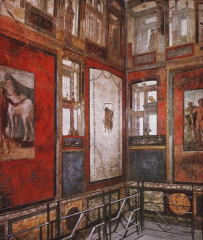
4th style paintings at the Ixion Room, Vetti House
Roman Imperial: 27 BCE- 312 AD |
4th style paintings @ the Ixion Room, Vetti House:
- invented in Nero's reign, spread to Vetti - Dada @ bottom imitates stone, plants form columns & divide the wall into sheets of solid color with floating images in the middle. -windows seem to be punched through to the outside |
|
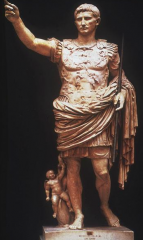
The Augustus of Prima Porta
Roman Imperial |
The Augustus of Prima Porta:
- depicts Augustus, 1st Roman emperor of the imperial period - considered to be one of the most accurate copies of the classical Doryphoros -- indicates that he is godly |
|
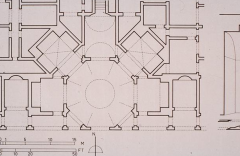
The Domus Aurea
Roman Imperial |
The Domus Aurea, Rome:
- commissioned by Nero - top portion= vaulted octagon, set on a circular room - inside the imperial palace: jumble of strange angles - cast concrete: uniquely Roman -room rotates, oculus allows light tocome in from ceiling -decorated by frescoes in the 4th style. |
|
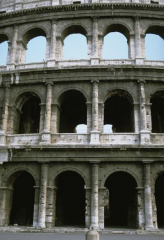
The Colosseum, Rome
Roman Imperial |
The Colosseum, Rome:
-feat of practical engineering -concrete structure, consists of groin vaults (intersecting barrel vaults) - rooms underneath used for storing props & special effects equipment - covered w/ retractable canvas roof - Greek order applied @ practical Roman core. |
|
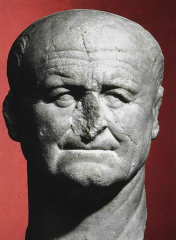
Portrait of Vespasian
Roman Imperial |
Portrait of Vespasian:
- Roman general - revived the veristic tradition of the Republican era-- great contrast w/ Nero's self-indulgence and extravagance |
|
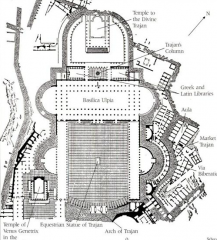
Forum of Trajan
Roman Imperial |
Forum of Trajan:
- last & largest forum of Imperial period - Trajan: great emperor, general over Barbarian tribes, donated wealth to building public monuments |
|
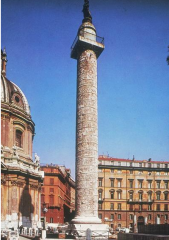
The Column of Trajan
Roman Imperial |
The Column of Trajan
-supports portrait statue of Trajan - Tuscan Doric column with base, except that the smooth part has been replaced with a band of decoration, depicting hundreds of figures playing out Trajan's battles with Barbarians. |
|
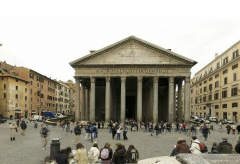
The Pantheon
Roman Imperial |
The Pantheon:
-Roman-style "temple" - instead of a cult statue, the assumed "cella" is instead a domed room, large enough to hold many people - ceiling acts as celestial sky & lower part acts as Earth (Domus Aurea inspired) - functioned as public audience hall & as the Domus Aurea did. |
|
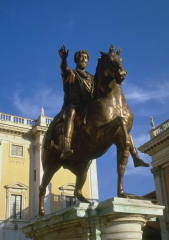
The Equestrian Statue of Marcus Aurelius:
Roman Imperial |
The Equestrian Statue of Marcus Aurelius:
- arm stretched out, act of clemency - horse's leg once stood on cowering enemy -superhuman stature- much larger proportionally than a man would be to a horse. |
|
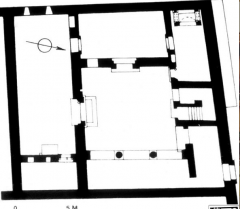
Christian House, Dura Europos
Roman Imperial 27 BCE -312 AD |
Christian House @ Dura Europos:
- 1st evidence of Christians - located in the city of the Roman empire, modern-day Syria -fortification wall surrounds city, with most important buildings and temples @ forum; this house was on the outskirts & near the fortification wall: got buried in an attempt to strengthen it from invaders. -secret cult building, not official temple -mall and modest, most Christians were poor & lower class -modifications done mostly in the initiation ceremony room, with a bathtub for baptism |
|
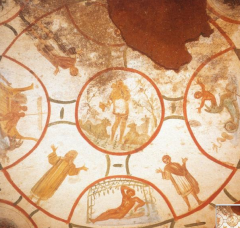
Catacombs of Peter & Marcellinus, rome
Roman Imperial |
Catacombs of Peter & Marcellinus, Rome
-upper vault area: 3rd style painting- big sheet of white, compartmentalized & decorated with images -- Jonah & the whale: Jew thrown overboard, swallowed whole by a whale & 3 days later is vomitted out; symbolic of the death & resurrection of Christ |
|
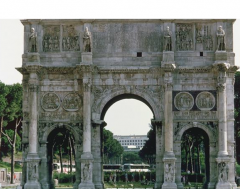
The Arch of Constantine, Rome 312-315
Early Christian |
Arch of Constantine, Rome
- PAGAN not christian (Constantine personally converted in 312, not nationally) - triple arch w/ tons of sculpture & relief - imperial portrait pictured becomes formula for representation |
|
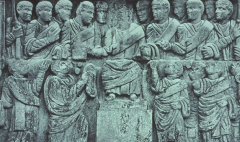
Detail of the Arch of Constantine
|
Arch of Constantine, Rome
-imperial portrait - emperor sits in the center, as others stand - face fell off-- would have been made of a precious stone or metal |
|
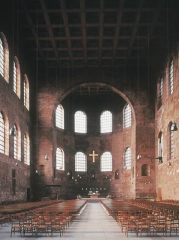
The Aula Palatina, Trier, Early 4th C.
Early Christian |
Aula Palatina, Trier, 4th c.
- rectangular hall w/ coffered ceilings, apse, and raised platform for emperor's throne - became standard layout of imperial audience hall basilica |
|
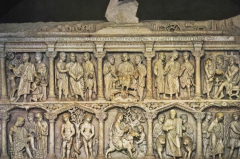
Sarcophagus of Junius Bassus, c. 359
Early Christian |
Sarcophagus of Junius Bassus, c. 359
- old patrician family of Pagan era - covered w/ various old Jewish stories & new Christian ones - portrait of Christ--- modeled after imperial portrait |
|
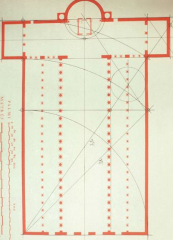
Old St. Peter's, Rome, begun c. 319
Early Christian |
Old St. Peter's, Rome, 319
- 2nd most important building in Christian world (1st: Christ's tomb) - killed as blood-sport entertainment - tomb developed into lavish structure, basilica - 5 aisles, clerestory windows, exposed rafters, trasected "T" shape basilica fuses tomb w/ audience hall |
|

Santa Costanza, Rome, begun 337
Roman Early Christian |
Santa Costanza, Rome, 337
- centrally-planned building -ambulatory: ringlike barrel vaulted corridor, separated by 12 pairs of columns -brick exterior |
|

Leaf from the Nicomachi/ Symmachi diptych
Roman Early Christian |
Leaf from the Nicomachi/ Symmachi diptych
- 2 panels: possible wedding announcement - depicts 2 pagan priestesses/ gods in the Greek classical style - attempts to justify the now-illegal religion of Paganism through emotional persuasion; "good ole days" & tradition |
|

Hagia Sophia, Constantinople, mid 4th c. (original); rebuilt around 532
Early Byzantine: 527-726 AD |
Hagia Sophia, Constantinople
- originally built by Constantine in the mid 4th century as 5-aisle basilica church, but destroyed during a riot in Justinian's rule - rebuilt around 532 AD as centrally-planned building, stretched octagon w/ two thrones (bishop & emperor) -vertical axis btw. high central dome & floor instead of traditional horizontal axis - embedded within palace architecture; dual function as city's cathedral & emperor's cathedral -decorative nonfunctioning walls hide supporting buttresses |
|
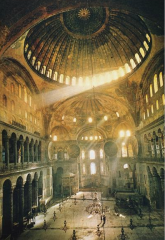
Interior of Hagia Sophia, 532
|
- divided heaven & earth inside; pendentives (triangular spherical segments) make up top half
with holy images in golden mosaics, lights that let natural light in - bottom half represents earth, darker colors and mosaics portray mountains, meadows, streams, etc. -Natural light acts as stars & planets |
|
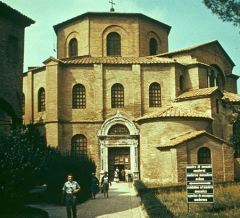
San Vitale, Ravenna
|
San Vitale, Ravenna
-true centrally-planned building: dome within an octagon, within an octagon -true "Byzantine" church -basket capitals: lacelike exterior hides hollow inside |
|
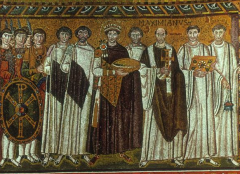
Justinian Mosaic, San Vitale, Ravenna
Early Byzantine |
-panel depicted inside church
-mosaic -depict Justinian & wife Theodora in "icon" fashion -icons used emperor & God interchangably |
|
|
functions of an icon portrait
|
1) intercessory: acts as a intermediary between humans and Gods-- have to pass prayers through lower level saints, all the way up the hierarchy to Christ.
2) Anagogy: turns attention away from material world, and into a higher realm. |
|
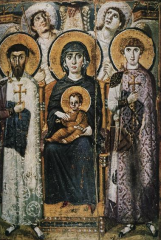
Icon of the Virgin, Saints, & Angels
San Vitale, Ravenna Early Byzantine |
Icon of the Virgin, Saints, & Angels
- baby Jesus is only an attribute to Mary, the central figure, so this is a Virgin Icon - accompanied by lower level saints, higher saints, angels, and the hand of God, which is speaking down to Earth. Shows the lineage prayers must follow. |

